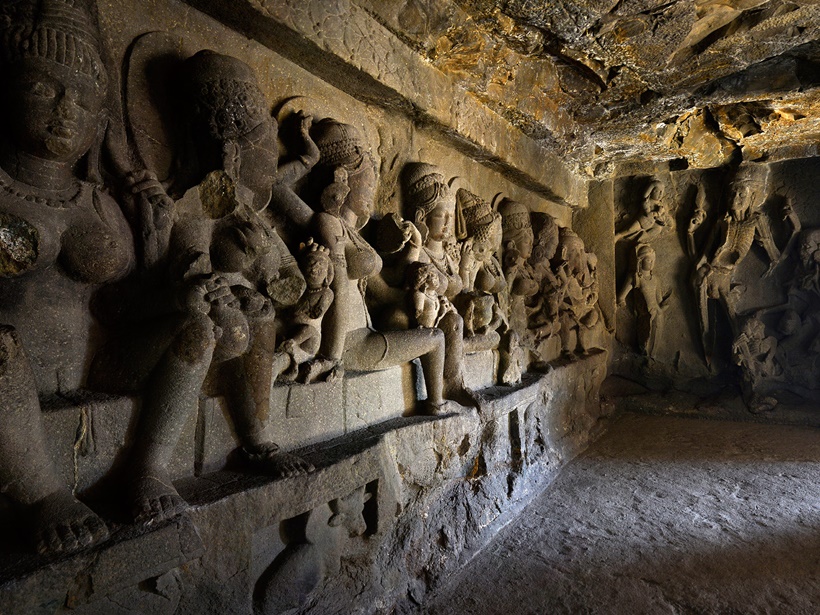In the third edition of this series on Indian monuments by Sahapedia, we look at the popular Ellora Caves, which is perhaps one of the most fascinating sites in India. Built over 500 years, nowhere else would you be able to find such a congregation of all the major religions of ancient India in one place.
By Navina Lamba & Shruti Chakraborty
The rock-cut Ajanta and Ellora Caves (often visited together) are not only a popular tourist destination in central India, but are an important part of India’s religious and architectural heritage. But what makes the 34 rock-cut caves of Ellora particularly unique is that they house monasteries and temples of the three major religions of ancient India—Buddhism, Hinduism and Jainism. This architectural marvel stands as a symbol of religious tolerance characteristic to ancient India and brings the ancient civilisation to life.
This is the reason why art historian and sculptor Prof. Deepak Kannal, in an interview with Sahapedia, calls Ellora “one of the most fascinating sites in India”. UNESCO recognised both the Ajanta and Ellora caves as World Heritage Sites as early as 1983, calling the latter “a unique artistic creation and a technological exploit”. In fact, Ellora was not just a religious site; its location on an ancient South Asian trade route made it an important economic and commercial centre as well. The site finds mention in several ancient texts, often as Elapura, as it was once known.
The Ellora Caves also show a synchronisation of many different architectural and aesthetic languages. Although the exact date of when work at Ellora began has not been identified, it is known that the site was a centre of art activity from the 5th to the 11th centuries, patronised by many dynasties, including the Chalukyas, the Rashtrakutas, the Kalachuris and many others. There are also some records of the caves being used by Jain visitors up until the 13th century, after which the region came under Islamic rule.


ARCHITECTURE AND STRUCTURE
Extending over two kilometres, the 34 caves are divided into three sections — almost one-third are distinctly Buddhist, caves 14-29 depict Hindu iconography and the last five are attributed to Jainism. Kannal divides the art activity at the Ellora caves into two phases—the Early Phase (5th to 6th centuries) and the Rashtrakuta Phase (around the 7th century onwards). It is imperative to note here that though only 34 caves are accessible to the public today, it is said that there are over 100 caves in total on the site.
Prof. Shrikant Ganvir, an expert on ancient Indian history and culture, says that Ellora was an important centre of tantric Buddhism. “The religious imagery at Ellora shows that tantric Buddhism was very much developed by this time in the western Deccan and flourished from the 7th century onwards till the early 10th century… The tantric Buddhist imagery which we get at Ellora is quite interesting as some of the icons do not match with the textual description. So it can be suggested that tantric Buddhist icons at Ellora were excavated even before standard Buddhist tantric texts were codified or were being circulated,” he says in his extensive interview for Sahapedia.
The Rameshvara (Cave 2) is considered to be the finest caves at Ellora from the first phase. From Rameshvara to Ravan ki Khai (Cave 14), one sees an obvious similarity in the ground plan. However, the architectural alterations, like the circumambulatory path around the garbhagriha (the sanctum sanctorum of temples), shows the evolving architectural and aesthetic sensibility of this phase. It was these interactions between different visual languages of guilds of different dynasties that allowed the surfacing of a composite style in the later phase of Ellora.
An important temple in the complex is the Kailashnatha monolith, which is not only one of the largest temples in Ellora but is arguably the largest monolith temple in the world. Situated outside Dashavatara (Cave 15), the monolith is said to have been built in the 8th century.
ELLORA, AJANTA AND ELEPHANTA
Another thing that makes the Ellora Caves fascinating is its architectural similarities with other, non-contemporaneous cave structures, such as Ajanta and Elephanta.
While the Ellora Buddhist cave architecture is simpler, it is grander in scale than Ajanta. Stylistically, there’s a similarity between the two, especially in the Buddhist caves. That is why many see Ellora as a sequel to Ajanta.
Scholars also believe that the Ellora caves share similarities with the ones found at Elephanta (close to Mumbai, Maharashtra, and also said to have been built between the 5th and 9th centuries), especially Dhumarlena (Cave 29)—the last cave, both physically and chronologically, from the early phase. It follows the ground plan and the sculptural type of Elephanta quite faithfully and the Kalachuri lineage is quite discernible.
A POEM CARVED IN STONE
According to Kannal, “Marathi scholars believe that the inscription found in Jnaneshvara’s Kuta Kavya is puzzle poetry or mysterious poetry. He says, ‘Chinchechya pani ek mandira bandhile, Adhi kalas mag paya re’, or ‘A temple was constructed on a tamarind leaf and the finial was built first and then the foundation was excavated.’ This is very interesting imagery. People believe that Jnaneshvara must have visited this place. I personally think that Ellora itself is a Kuta Kavya. Ellora itself is a mysterious poem carved in stone.”
Also Read| Know Your Monument: Rani ki Vav, which is on the new Rs 100 note!
DID YOU KNOW?
– Not known to many, Ellora was an important centre of Tantric Buddhism, especially in the western Deccan region.
– Nowhere else in India would you be able to find the monuments of three major religions of ancient India—Buddhism, Hinduism and Jainism—in one place.
– The Kailasanath mandapa from the Rashtrakuta phase was the first successful attempt at carving a proper monolith. In fact, it is said to be the largest Buddhist monolith temple in the world.
– The Jain caves (Caves 30-34) are collectively called Indrasabha because they are actually one cave with several entrances.
Also Read| Know Your Monument: Chhatrapati Shivaji Terminus
– While visiting, pay particular attention to Caves 2 (one of the finest at the site), 10 (Buddhist mantra cave), 11-12 (storeyed caves; No. 12 depicts a host of Buddhist female deities such as Tara, Janguli, Chunda, Bhrikuti, etc.), 15 (still incomplete, one can see different styles here), 16 (Kailasa, enough has been said about this), and 30-34 (collectively called Indrasabha because they are actually one cave with several entrances).
(This article is based on the module on Ellora Caves on www.sahapedia.org, an open online resource on the arts, cultures and heritage of India. Sahapedia offers encyclopedic content on India’s vast and diverse heritage in multimedia format, authored by scholars and curated by experts to creatively engage with culture and history to reveal connections for a wide public using digital media.)
Source: Read Full Article





